Marrying Vega and Zen: The AMD Ryzen 5 2400G Review
by Ian Cutress on February 12, 2018 9:00 AM ESTiGPU Gaming Performance
Throughout their history of having fully integrated GPUs, AMD has always favored going for powerful configurations that approach the lower-end of discrete GPU performance. With comparable discrete cards going for $80 or more, a powerful iGPU is a significant value proposition for AMD’s APUs. Furthermore as Intel has continued to stick with relatively lightweight iGPUs for most mainstream SKUs – a trend even the newly released “Coffee Lake” 8th Gen Core family continues – AMD has easily trounced Intel’s iGPU performance.
In fact the most recent 8th Gen Core CPUs generally fail to catch up to AMD’s last-generation 7000/8000 series “Kaveri” APUs, which means that for the launch of AMD’s new Ryzen APUs, the manufacturer is just going to be running up the lead even more. The real question we’ll be looking at on the iGPU side isn’t what’s faster – that’s obvious – but just how many times faster the 2400G & 2200G APUs are over their Intel equivalents, and how they stack up against an entry level discrete video card, the GeForce GT 1030. With upwards of 11 CUs in an APU, on paper the Ryzen APUs should be able to offer 1080p@30fps gaming at maximum (or near-maximum) image quality.
During our pre-briefing, several sets of benchmarks and configurations were 'suggested', focusing on eSports and a mid-range quality setting, to show what the platform can do. For our testing, we used our CPU Gaming 1080p gaming suite. This suite was developed with mid-range and high-end graphics cards in mind, with mostly high or ultra quality settings, pushing beyond what was suggested. The reason we did this was two fold:
- In our data, it shows a sizeable difference between integrated graphics solutions that can offer potential, compared to those that fall at the first hurdle.
- Second, it offers a stark reminder that while for the most part websites and enthusiasts like as way lyrical about high-end performance, the data shows both how far integrated graphics has come, and how far it still has to go to qualify for those 'immerse experiences' that Intel, AMD, and NVIDIA all claim are worth reaching for, with higher resolutions and higher fidelity.
Civilization 6
First up in our CPU gaming tests is Civilization 6. Originally penned by Sid Meier and his team, the Civ series of turn-based strategy games are a cult classic, and many an excuse for an all-nighter trying to get Gandhi to declare war on you due to an integer overflow. Truth be told I never actually played the first version, but every edition from the second to the sixth, including the fourth as voiced by the late Leonard Nimoy, it a game that is easy to pick up, but hard to master.
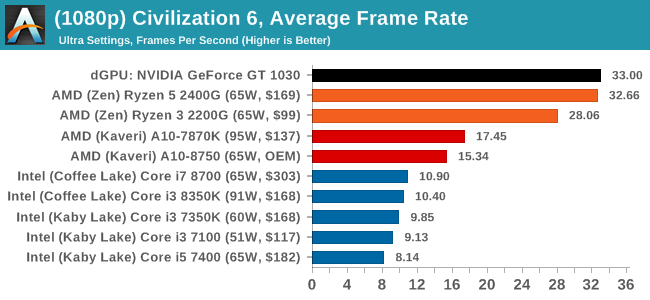

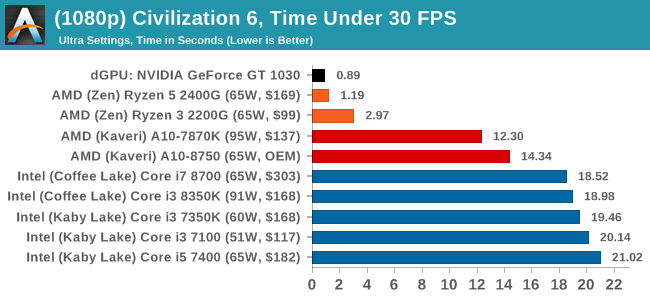
While Civilization is not too limited to frame rates, the APUs straddle the 30FPS average, and the GT 1030 comes out on top just about. Intel's integrated graphics options are only 1/3 of what AMD is providing in this case.
Shadow of Mordor
The next title in our testing is a battle of system performance with the open world action-adventure title, Middle Earth: Shadow of Mordor (SoM for short). Produced by Monolith and using the LithTech Jupiter EX engine and numerous detail add-ons, SoM goes for detail and complexity. The main story itself was written by the same writer as Red Dead Redemption, and it received Zero Punctuation’s Game of The Year in 2014.
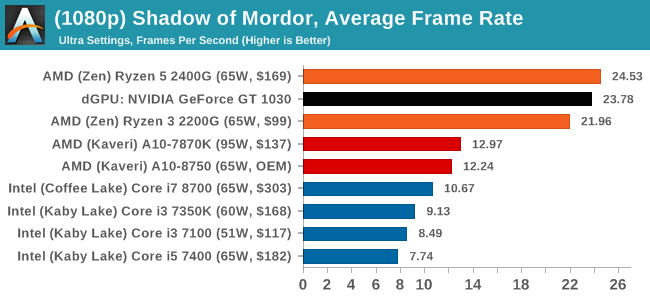
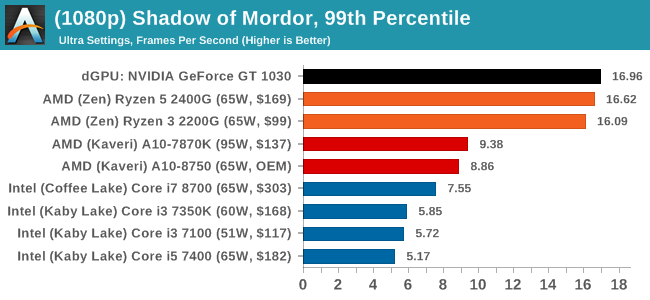
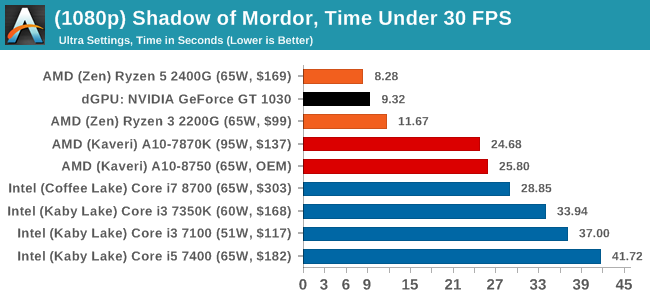
In Shadow of Mordor, the 2400G takes the top spot in average frame rates, but the GT 1030 just wins on percentiles. Over Kaveri, AMD is now offering double the graphics performance, and over Intel, AMD is easily 2-3x in performance per dollar.
Grand Theft Auto V
The highly anticipated iteration of the Grand Theft Auto franchise hit the shelves on April 14th 2015, with both AMD and NVIDIA in tow to help optimize the title. GTA doesn’t provide graphical presets, but opens up the options to users and extends the boundaries by pushing even the hardest systems to the limit using Rockstar’s Advanced Game Engine under DirectX 11. Whether the user is flying high in the mountains with long draw distances or dealing with assorted trash in the city, when cranked up to maximum it creates stunning visuals but hard work for both the CPU and the GPU.
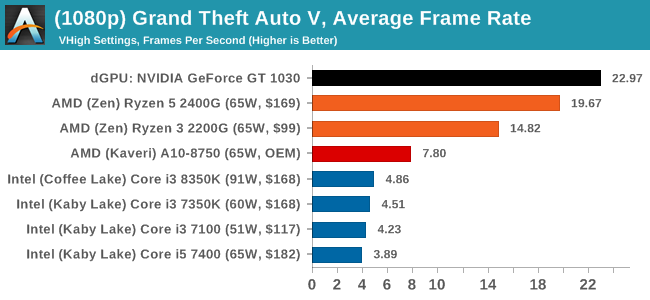
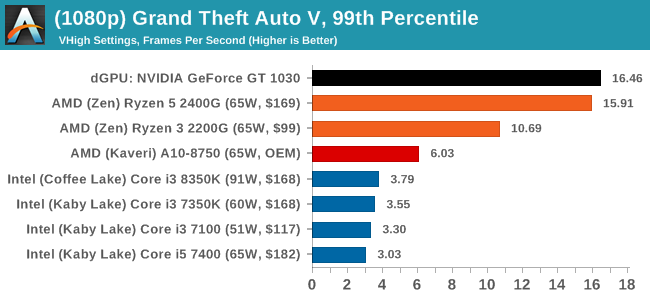

The difference between something playable and a slide show was easily noticable in GTA. The GT 1030 had the legs on this one, although the gap between the two AMD parts was mostly noticable in 99th percentile numbers.










177 Comments
View All Comments
Hurr Durr - Monday, February 12, 2018 - link
I don`t care about these. I want to see how AMD is holding up in notebooks, 15W range specifically.Hul8 - Monday, February 12, 2018 - link
For a low-end graphics part like this, it would be really interesting to have a section in the review exploring the "comfortable" settings in various games.It could be really useful information for potential buyers to know what kind of settings they'd need to run in a game to reach their preferred performance level (99th percentile), whether it's 30, 45 or 60 fps, and also to know if a product simply can't reach certain performance no matter how low you turn the settings.
DrizztVD - Monday, February 12, 2018 - link
Why do you only report total power consumption? I'd like to see power efficiency!!! Since I don't know what the performance per CPU is, these power measurements mean almost nothing. Also, the efficiency will change with the workload, so Prime95 is a very one-dimensional test of efficiency. Look at your power measurement graphs: they tell you what we already know - single core speeds are lower for Ryzen, and lower TDP CPUs use less power. That's kinda duh...JHBoricua - Monday, February 12, 2018 - link
I'm confused. The AMD vs. AMD section led me to believe there was going to be a comparison of Raven Ridge against Bristol Ridge APUs, which makes sense as it would have allow the use of the same motherboard for both APUs, even if the Bristol Ridge DDR4 memory was clocked slower. But then actual benchmarks is showing Kaveri parts?prtskg - Tuesday, February 13, 2018 - link
Kaveri was better at gaming/performance than Bristol. The latter had the advantage of efficiency.nwarawa - Monday, February 12, 2018 - link
Comparing with a competitive Intel platform with dGPU is kinda tricky right now. It's not just the dGPUs that are ridiculously priced right now. RAM is too. And to maximize performance on the R7 2400G, you WILL need to spend more than the basic $90 8GB 2400 kit. The cheapest 16GB Samsung b-die 3200 kit I found was $220. And you will want to go with a 16GB kit, because already some newer games use more than 8GB, and they use MORE when using graphics cards with less than 4GB. The iGPU takes some of that 8GB for itself...if runs out of system RAM, it has to use your system disk... enjoy the single digit frame rates...Here is what I found on newegg:
INTEL
$130 - i3-8100
$90 - 8GB 2400 RAM (or 170 for 16GB)
$120 - Z370 motherboard (no mainsteam chipset YET)
===
$340
AMD
$170 - R5 2400g
$220 - 16GB 3200C14 RAM
$80 - Motherboard(cheapest decently reviewed AM4)
===
$470
The intel system is a full $130 cheaper (or $50 if you spring for the 16GB), and that gap will only increase with the upcoming cheaper chipsets and/or upcoming coffee lake models. Now, I haven't included the dGPU yet, but the GTX1050 2GB currently goes for $150 - making the Intel system total only $20 more than than AMD system, and running rings around it in most games (although neither would be ideal for the latest games... the 2GB-GPU/8GB-SYSRAM Intel system would run out of memory and the Vega 11 just doesn't have the horsepower).
What would put things in favor of AMD would be if they made clear that the iGPU would still be of use when using a dGPU (such as with the new "ThueAudioNext") in the future.
What I would REALLY like to see, though, is AMD use the beefier Vega iGPUs Intel is using with their own 12nm Zen+ chips and slap on some HBM memory. THAT I could go for.
oleyska - Monday, February 12, 2018 - link
Jeez,1.\ HBM on budget chips pushes them into 250$ range by just adding HBM.
2.\ IGP solutions are not a GTX1060 replacement, it's not magic.
System comparison:
I3 8100 is inferior in cpu tasks.
it has half the memory (intel IGP still uses memory you know?, it's configurable on both systems.
The benchmarked system runs at 2933, not 3200 so o.0
it has inferior gpu 3X~
even at same memory speeds it would still be 2X as slow, slower cpu.
So what is the point of the argument ?
It not needed to have the extra memory frequency but if you want to replace a 80$ dedicated gpu you need to and definitely add 8gb extra memory and that's where the cost comes into place as a valid comparison if you subtract 20$ from AMD for 2933 ~
add 80-100$ for GT1030 you still end up with an intel rig with higher system power consumption, equal gaming performance, inferior cpu and you will have to buy a G-sync monitor if you want tearing free monitor while freesync is thrown at ya at any price range as an added bonus.
systems are comparable and Intel's I3 line is destroyed along amd's old R3 line too.
I5,I7 and R5 stands tall still and the R7 has it's place at times too.
nwarawa - Monday, February 12, 2018 - link
Did you not even read my post? Or the review for that matter? Did you think AT ALL about the real life application of anything said before posting? "I3 8100 is inferior in cpu tasks" WHAT tasks? I'll answer that for you. Rendering. If you are trying to get the cheapest CPU possible for rendering with as little RAM as possible to shave as much money off as possible... you are doing it wrong. Since we (or at least I am... not sure what you are going on about) are talking about GPUs, you can safely assume we are concerned about GAMES."it has half the memory" no s--t, sherlock, read the post again (or for the first time, apparently)
I could go on, but apparently you were just scouring the posts for someone to disagree with with a pre-defined little rant, so I won't bother.
Fritzkier - Monday, February 12, 2018 - link
Why you need 16GB? if you bought Ryzen APU, you probably only plays e-sport title anyway and some older games... E-sport titles doesn't need a huge RAM. And it already crush the intel counterparts, both in performance and price.You guys from first world countries are always complaining. Jeez. Try to live at poorer countries like South East Asia.
serendip - Tuesday, February 13, 2018 - link
An APU at $100 would still be expensive, especially when people in the developing world build machines with Pentium G chips. The speedy APU graphics would negate the need for a low-end discrete GPU though.